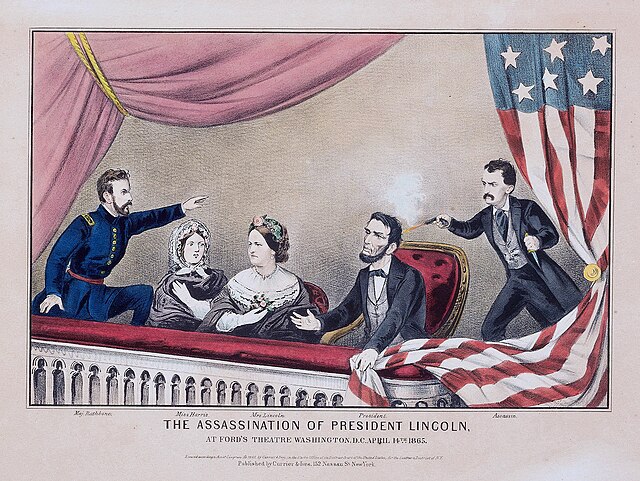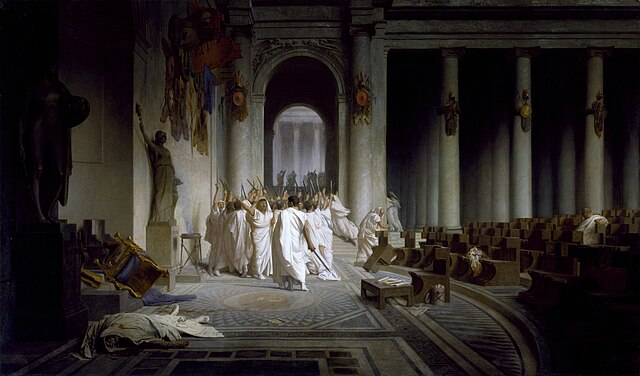willful killing of a prominent person, often a political leader or ruler From Wikipedia, the free encyclopedia
Assassination is the murder of an important or popular person, usually, a political leader, like the head of a country or of a political party. Assassinations are usually done for political reasons or for payment.[1] A person who assassinates someone is called an assassin.


Throughout history, assassinations have happened for many different reasons. Sometimes, assassinations have been used to take over governments. Other times, assassinations have been used to kill military leaders during wars, or for religious reasons. Some assassins want revenge, or just want to be famous.
Assassinations have happened ever since people started living in group societies.[2]

The Old Testament of the Bible mentions assassinations in the Books of Judith, Kings, Samuel and Chronicles.[3]
An ancient Indian writer, Chanakya, who lived from about 350 to 283 BC, wrote much about assassinations in a book called Arthashastra. One of his students later assassinated some of his enemies, including two of Alexander the Great's generals.[4]
Famous victims of assassinations include Philip II of Macedon (336 BC), who was Alexander's father, and Julius Caesar (44 BC). There is evidence that Alexander was assassinated by poisoning. Several emperors of the Roman Empire were assassinated so that a different leader could take their place.[5]
In the Middle Ages, many emperors in the Byzntine Empire were murdered so that new emperors could take power.[6]
In the 12th and the 13th centuries, the Shia Order of Assassins in Persia and Syria fought their Sunni and Christian enemies by killing their leaders. That is when the term "assassination" started.
During the Renaissance, assassinations happened in Western Europe. Kings William the Silent of the Netherlands (1584),[7] Henry III of France (1589),[8] and Henry IV of France (1610)[9] were all assassinated.
An early use of state assassination in the area which later became the United States, happened in 1620. It happened in Plymouth in the Massachusetts Bay Colony, where the Pilgrims had landed. Native Americans already lived there, but the Pilgrims wanted the land to themselves. Myles Standish invited a local Native American tribal chief, the chief's 18-year-old brother, and two other Native Americans to a feast. They locked the door, killed the three older men and hanged the teenager in public as a warning to the other Native Americans to stay away.[5]

Assassinations have been common in modern history. This section does not list every assassination that has happened in modern history. It lists some examples of world leaders who were assassinated, and explains some of the reasons why these assassinations happened.
In Imperial Russia, two emperors were assassinated within 80 years: Paul I (1801)[10]pp. 16–17 and Alexander II (1881).[10]p. 419
In the United States, four presidents were assassinated within 100 years. They were Presidents Abraham Lincoln (1865), James Garfield (1881), William McKinley (1901), and John F. Kennedy (1963).[11]
After Abraham Lincoln was killed, Andrew Johnson became president for four years. During that time, 12 people who held important political jobs were assassinated.[5] The next president, Ulysses S. Grant, led the United States from 1869 to 1877 During that time, 11 government leaders were assassinated; another 9 were attacked, but survived.[5]
Archduke Franz Ferdinand of Austria was assassinated in 1914. Some historians say this assassination started World War I.[12]
In the 1930s and 1940s, Joseph Stalin's NKVD assassinated some people outside of the Soviet Union, including Leon Trotsky. They were mostly people who Stalin thought were against him or could take power from him. Stalin wanted to make sure to keep the power he had and so he killed many of his opponents, mostly within the Soviet Union.[13]

Between 1934 and 1944, different individuals and groups tried 27 different times to assassinate Adolf Hitler, the leader of Nazi Germany during the Holocaust and World War II. Objection to anti-Jewish policy and gaining better terms with the Allies were among the various motives for assassination. None of the attempts were successful.[14][15]
During World War II, the Allies used assassinations to kill important Nazi and Japanese leaders:

Some famous human rights activists were also assassinated in the next few decades. They were assassinated by people who did not like the things they were doing to work for human rights. The most famous activists who were assassinated include:[19]
Between 1960 and 1965, the Central Intelligence Agency (CIA) tried at least eight times to assassinate Cuban leader Fidel Castro.[20]p. 71 Around this time, the CIA also made plans to assassinate Patrice Lumumba, the only democratically-elected leader of the Democratic Republic of the Congo.[20]pp. 19–24
Between 1960 and 1970, the CIA also encouraged and in some cases helped with assassinations of the following:[20]p. 256

In 1979, the Iranian Revolution turned Iran into an Islamic Republic. A group called Iran Human Rights Documentation Center says that between 1979 and the 1990s, leaders of the Iranian government had 162 people assassinated, in 19 different countries.[21] The group says Iran stopped the assassinations because a German court put out an arrest warrant for the head of Iranian military intelligence.[22]
Anwar Sadat, the President of Egypt, was assassinated in 1981 at a parade.[23] He was killed by people who wanted to take over the country and make it into an Islamic Republic.[24]
In 1983, Benigno Aquino, Jr. was assassinated. Aquino was against Ferdinand Marcos, the dictator who ruled the Philippines. The people of the Philippines were so upset that they started the non-violent People Power Revolution, which led to the end of Marcos's government. Aquino's widow, Corazon Aquino, became President of the Philippines.[25]
In India, Prime Minister Indira Gandhi was assassinated in 1984.[26] Her son Rajiv Gandhi became the next Prime Minister. He was assassinated in 1991.[27] (They were not related to Mohandas Gandhi.)
Israeli Prime Minister Yitzhak Rabin was assassinated in 1995. The Israelis and Palestinians were working on a peace agreement. Rabin was killed by an Orthodox Jew who did not agree with the peace treaty.[28] Many historians think Rabin's murder is one of the main reasons the peace talks fell apart.[2]
In Pakistan, Benazir Bhutto was assassinated in 2007. Bhutto had been the first woman who was ever elected to lead a Muslim country.[29] An Al-Qaeda leader said that Al-Qaeda assassins had killed Bhutto. He said that it did so because Bhutto was trying to get rid of violent Jihadist militia groups in Pakistan. He said this made her important to the United States, so Al-Qaeda killed her.[30]
In the 2020s, President of Haiti Jovenel Moïse was assassinated in 2021 and former Prime Minister of Japan Shinzo Abe was assassinated in 2022.
One research study looked at assassinations of national leaders (leaders of countries, like presidents or prime ministers). The study showed that:[12]
Another study looked at all assassinations between 1946 and 2013. It included not just national leaders, but also other members of government (including local governments), and people who were against the government. This study found that between 1946 and 2013, a total of 954 people were assassinated in 758 different attacks.[2]
This study also looked at who was most likely to be assassinated. Of the 954 people who were assassinated:[2]
Seamless Wikipedia browsing. On steroids.
Every time you click a link to Wikipedia, Wiktionary or Wikiquote in your browser's search results, it will show the modern Wikiwand interface.
Wikiwand extension is a five stars, simple, with minimum permission required to keep your browsing private, safe and transparent.